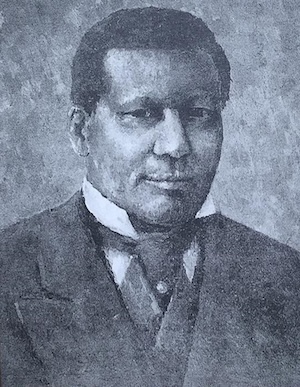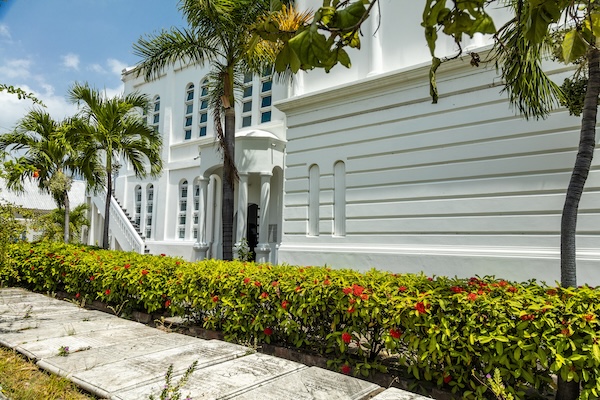Congregation Sha’are Shalom in Kingston, Jamaica. (photo from Jamaica Tourist Board)
It was a muggy Friday afternoon just hours after my family and I had touched down in Jamaica for a two-week vacation, and the plan was to attend evening services at Kingston’s only synagogue, Congregation Sha’are Shalom. Too tired to argue, my kids and spouse changed clothes, we squashed six into the rental car and ventured into the city.
Though we knew the stately synagogue on Kingston’s Duke Street had been there since 1912, it still felt surprising to go inside and find eight members of the tribe leading a Shabbat service. The two-level synagogue is a magnificent piece of architecture, with a majestic, mahogany aron hakodesh filled with Torah scrolls from other Jamaican synagogues that closed or merged over the years. The ground floor is composed of sand, making this one of just five sand-floored synagogues worldwide. One story says the sand hearkens back to when Jews were worshipping in basements in Spain and Portugal, during the Inquisition, and sandy floors silenced their footsteps. Another legend says the sand is there as a reminder that we should multiply like sand on the seashore.
Sha’are Shalom has space for at least 300 congregants, but when we arrived, there were just the eight locals and the six of us. The deep, sonorous baritone of one member, who led the service from the mahogany bimah, filled the air with a spiritual melody and, above us, ceiling fans whirred, adding a reprieve to the humid evening. From the bimah, Stephen Henriques, the spiritual leader, spoke of the dispersal of Kingston’s Jewish community over the past four decades, adding that many of today’s members are interfaith. “Still, we are here, celebrating and living our Jewishness, as we have done for centuries,” he said.
We were warmly welcomed to the service, and happily joined in a kiddush of grape juice, challah and sweet Jamaican coco bread. I tried to imagine a time when the synagogue was brimming with Jews, its walls resonating with children’s laughter, congregants’ prayers and Jewish possibilities. There were times like this, but they happened many, many years ago.
Jamaica was occupied by the Spanish from 1494 until 1655. During that time, Jews from Spain and Portugal began trickling onto the island. With the Spanish Inquisition underway, those Jews became Marranos, practising their faith in secret. In 1655, when the British occupied Jamaica, Jews were able to practise their faith without secrecy, but they weren’t completely free from discrimination. Between 1690 and 1740, a “Jew Tax” was levied and only in 1831, the year of the largest slave rebellion in the country, were Jews allowed to vote and participate fully in public life.

Jews had been quietly involved for years before that, but they embraced this opportunity with gusto. By 1849, eight of the members of Jamaica’s House of Assembly were Jewish. George Stiebel, a Jewish businessman who made his fortune in gold mining in Venezuela, was the country’s first Black millionaire, in 1881. He built Devon House, one of the country’s flagship mansions and a national monument today.
We continued to nibble on coco bread in the Jewish Heritage Centre adjacent to the synagogue, wishing we had more time to peruse the walls, where there is lots of historical data on Jewish contributions to the island. It was dark by the time we left, so we didn’t have time to see the memorial garden, where tombstones dating back to the 18th century have been relocated.
A few days into our stay, we left Kingston for Ocho Rios and Montego Bay on the north coast. When the sun shone, we explored Jamaica’s beaches, relishing the feel of the warm water on our skin. When the rain came pouring down, we drove to neighbouring parishes to explore small towns.
One such drive took us to Falmouth, a small town whose poverty and neglect is loudly revealed in its deeply potholed roads and dilapidated homes and buildings. Coming, as we did, from an all-inclusive resort just 20 minutes away, the disparity between the two environments was glaring.
But it wasn’t always this way. The Jewish cemetery in Falmouth is filled with the graves of Jewish merchants who dominated the once-flourishing trade here in the 19th century. When I announced we were making a stop at the cemetery, there was a collective groan from the back of the car. “We went to synagogue – now we have to visit dead Jews?” my son asked. As my husband valiantly navigated through potholes the size of small swimming pools, I tried to explain how a cemetery could be a fascinating place to explore history.
Though we were probably only a stone’s throw away from the cemetery, we never made it. After one particularly large pothole, and another ahead that threatened to drown the rental car, a decision was made. “I love you, sweetheart, but I just don’t want to get stuck out here,” my husband declared.
I couldn’t blame him.
Drive around Jamaica and safety is not a feeling that comes easily. For one, the drivers overtake with such reckless disregard for life that road accidents always feel imminent. For another, the looks you get from some locals leave your Spidey sense tingling with fear. Leave the resorts and there are few warm welcomes from the community at large it seems, with the exception of those who have something to sell. Jamaica is known for its violence, with a rate of 52.9 homicides per 100,000 people, as compared to Canada’s, at 2.5.
We turned around and headed back to the resort, where staff sweep trash off the beach daily, and food and booze are readily available day and night. Moving between the pool and the ocean, it didn’t take long to relax. As the mojitos flowed, though, my mind kept returning to those tenacious Jews who arrived in Jamaica hundreds of years ago. They came with sand in their shoes and buckets of determination to pursue their religion and build success in a new land. I wondered what they’d say if they could see Jamaica today.
Lauren Kramer, an award-winning writer and editor, lives in Richmond.

